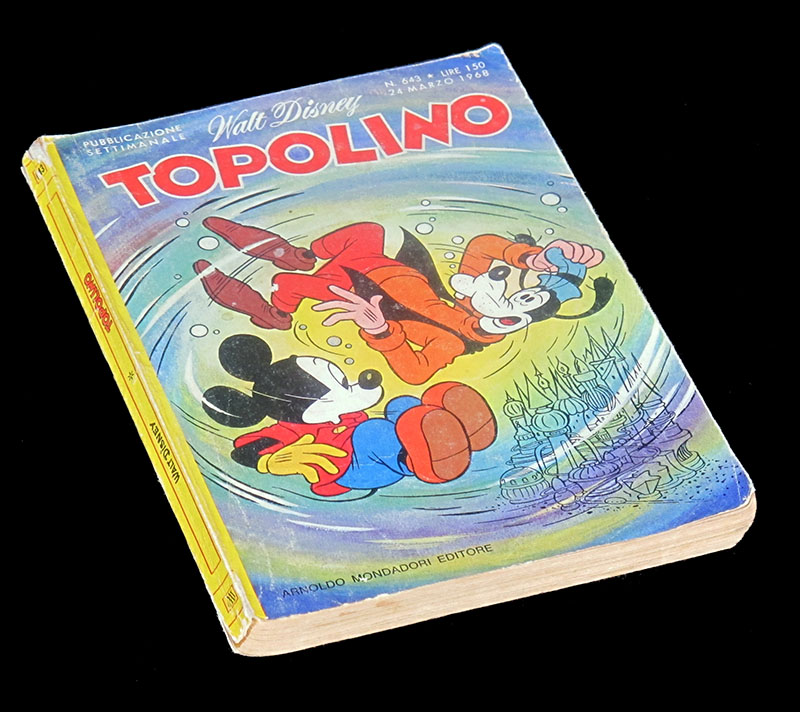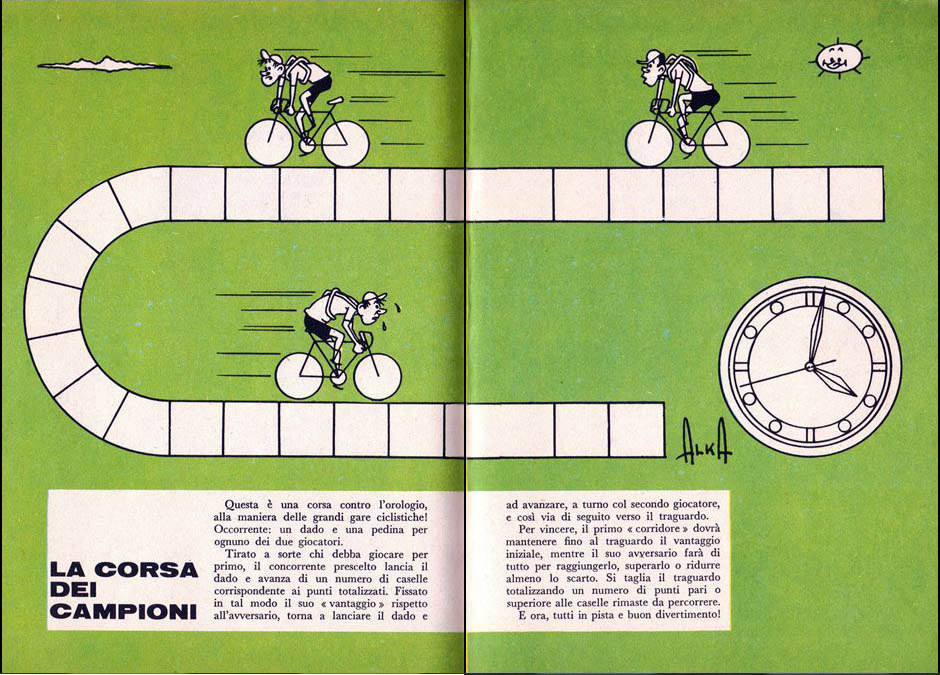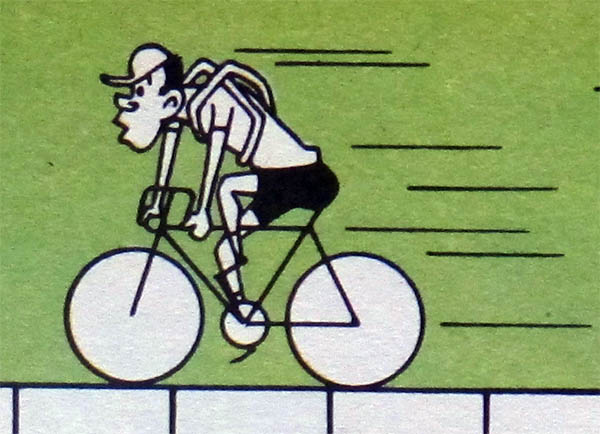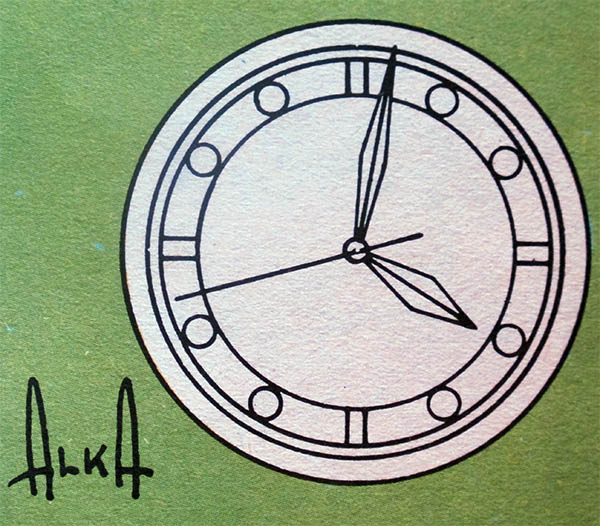
LA CORSA DEI
CAMPIONI
Alka, Topolino, Italy, 1968

Games issued on the inner pages of magazines are not unusual, but they are hard to spot. However, every now and then someone finds yet another. My friend Roberto, from Rome, has unearthed this little game in the Italian Topolino, in issue 643 (March 24th, 1968, pages 86-87). It is the second Topolino game he discovers!
At first sight, this game looks quite unpromising, doesn't it? The game, based on simple roll-and-move mechanics, is supposed to represent a time trial race for two players.
The name of the game, "Corsa dei Campioni", reminds somewhat of the famous time trial race Criterium des As. I have not found any indication that the Criterium des As was called Corsa dei Campioni in Italy (and there is an Italian game called "Criterium degli Assi"), but there is a similarity. If you realize that the Criterium des As was won for the first time by an Italian rider, Felice Gimondi, in 1968, it could be tempting to imagine that the game was dedicated to that win. However, it is just a coincidence: the actual race was run on October 13th, more than 6 months after this game was published.
The rules are very simple. The first rider (let's call him "A") rolls a die and advances the thrown number of squares, thus establishing an initial gap. After that, both riders play in turns, starting with the same rider A, until either A reaches the finish line or the second rider ("B," of course) catches A. To win the game, A has to keep the starting gap until the end of the race. On the other hand, B wins if he catches A OR if he manages to reduce the gap by the end of the game. The rules do not say if B has an extra throw in the event that A crosses the line without being caught.
As they stand, these rules are somewhat ambiguous and, as far as I can see, unbalanced. Rider B can win either by catching the first rider or by just reducing the starting difference, while the first rider has to avoid being caught AND keeping or widening the initial gap. By the way, an unbalanced race does not make an unbalanced game, since the role of each player is drawn by lots.
While the idea of a time trial race for only two riders seems quite weird, and the idea of having an unbalanced race does not help either, there is another way to look at this game, not as a time trial, but as the last kilometers of a breakaway rider trying to make it to the finish line before getting caught by the peloton. In this sense, a good name for the game would be "Flamme Rouge", but I am afraid it is taken. ;-)

So, while I think of a possible new name for the game (*), let me explain what I mean.
First, let's have a look at the board. It looks like there are 27 squares. I mean, I assume the longer squares are just one square. It is not clear, either, where the start and finish lines are. I assume they are at both ends of the track, so in fact there is a virtual square at each end of the track. If the squares on the board were numbered from 1 to 27 (which would be quite useful to play the game), there would be a square "0" and a square "28", even if they were only virtual.
These are my proposed rules:
Game for two players, A and B. A represents a breakaway rider, and B represents the peloton. The track is of length N (more on this later). At the start of the game both players stand on field 0 (outside the track), representing them to be in the same peloton. Cyclist A breaks away from the peloton by rolling a die and advancing the corresponding number of squares. From then on, both players roll by turns, starting with A, until either the breakaway rider (A) wins the game by crossing the finish line, or the peloton (B) wins the game by catching A.

At this point, you may be wondering where is the difference, and what is the interest of my variation. Apart from a small gain in playing "feel", the game remains childishly simple, with no strategy at all. So, if you want to make something interesting out of this game, let me ask you one question:
What should be the value of N (the length of the track) to make it a balanced game?
I mean, what is the "correct" length of the track to make it an interesting (though not strategic) game? The way I see it, if N is too small, A is favoured. If N<2 the game is trivial: player A will cross the line before B has even thrown the die. On the other hand, if the track is long enough (if N tends to infinity), B should eventually end up catching A (**). So there must be a value of N that makes the chances even. And there must also be a way to determine that value (which is not the same problem altogether).
I am waiting for your suggestions.

(*) About a possible name for this game: If I ever re-create this game as a free print'n'play download (do not rule this out), probably "PUNCHEUR" is a good name. (You know, a puncheur is the type of rider who attacks near the end of the stage, escapes the peloton, and tries to keep his advantage until the finish line.) I would also consider "CHAPATTE", after Robert Chapatte, who famously established that it takes a group of chasing riders ten kilometres to make a one-minute gain on a lone rider (this is known as Chapatte's law). But naming a game "Chapatte" is quite nerdy, isn't it?
(**) Note for the VERY mathematically inclined: intuitively, if N tends to infinity, B should eventually end up catching A. However, long series of throws sometimes yield counterintuitive results. John Haigh's Taking Chances. Winning with probability gives examples of long series of coin tosses whose results are not what we would have first expected.
Thanks, Roberto, for the tip!
Description written in October 2023
 |
 |
 |
 |
 |
|
CULTURE IDEAS |
TOTUM REVOLUTUM THUMBNAILS |
NAMES ALPHABETICAL |
CATEGORIES LISTS |
WHAT'S NEW BLOG |